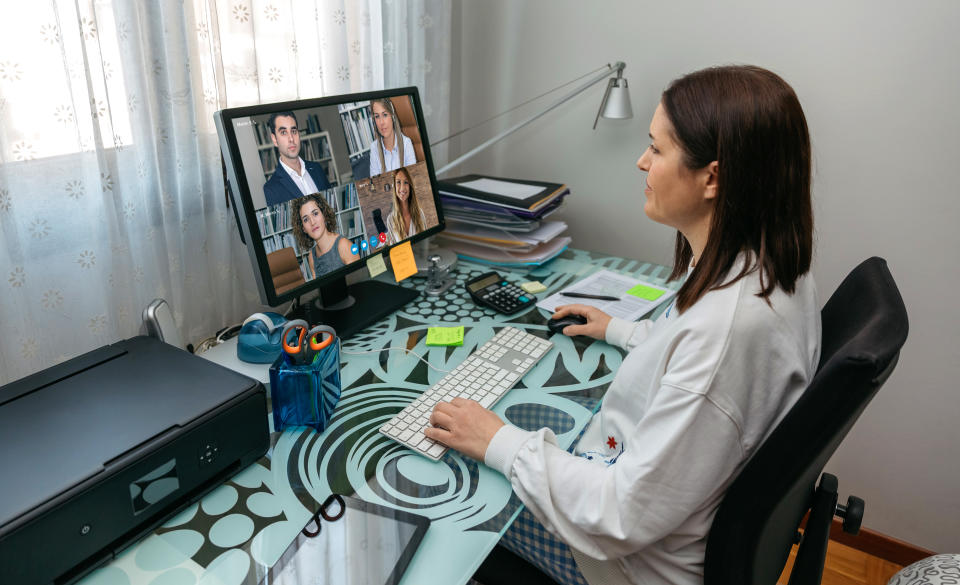Coronavirus: How to communicate effectively when video conferencing

Until a couple of months ago, few people had heard of Zoom – let alone used it every day. But since lockdowns were put in place and more people started working from home, using video conferencing software to take part in meetings, do presentations and chat to colleagues has become second nature for many people.
In the first quarter of this year, the demand for video conferencing apps has increased dramatically. According to a report by App Annie, enterprise-focused mobile app downloads reached 62 million mid-March: up 45% from the week before and up 90% from the pre-COVID-19 weekly download average.
Using Zoom, Skype, Hangouts and other apps in lieu of face-to-face meetings has allowed many people to continue working while at home, but it can take some time getting used to. Not only are there technical issues and interruptions from housemates, children and pets to deal with, speaking to your co-workers virtually is very different too. It can be difficult to get your point across when a large number of people are speaking at the same time – and the aim of the meeting can easily get lost.
So how can you communicate effectively when you are video conferencing?
Make sure you have a good internet connection
The most important aspect of video conferencing is making sure you have a stable and relatively fast internet connection. If the connection is slow, it will affect the conference with visual disruptions - your screen may freeze - and make it difficult to hear what people are saying.
READ MORE: Could virtual networking help people with social anxiety?
If possible, schedule video calls at a different time to avoid what experts dubbed the “cyber rush hour”. Many people organise meetings first thing in the morning, so pushing them back later may provide a more stable internet connection. It can also help to turn off the Wi-Fi connection on other devices linked to your network that aren’t being used, such as tablets or smart speakers.
Spend time on your set-up
Set up your camera so that it has a clear, unobstructed view of you. Make sure you aren’t sitting too far or too close to the camera and try to set it up so it is at eye-level. Make sure your face is well lit, preferably with natural lighting. A plain background will make it easier for other people to concentrate on what you are saying, too.
If you have a video call scheduled, make sure you set up your laptop in a quiet environment away from children, housemates and pets to avoid distractions. Sometimes, though, interruptions are inevitable. Under the current circumstances, many parents are having to juggle work with childcare and a lot of people are working in less-than-ideal circumstances. Employers should take this into account – and be understanding of the situation.
Set an agenda for the meeting
If you’ve ever sat through a meeting and wondered what the point of it was, you aren’t alone. A 2018 survey of 2,000 people from the UK, France, and Germany found employees waste almost 13 days a year in unproductive meetings, with the average employee spending 23 days every year. Of these, more than half were deemed unproductive by workers.
READ MORE: Why it's OK to take a break from Zoom meetings and virtual pubs
First, it’s crucial to make sure that the video conference is necessary – and that it definitely can’t be an email or a Slack message instead. If it is, make sure you have an agenda for the meeting and all employees have access to it. Setting clear objectives for a conference call will help keep people focused and stop the meeting from dragging on.
It can also help to have someone facilitate the conference call, to make sure everyone stays on track and to ensure all topics are covered.
Don’t speak at the same time
Anyone who has sat through a meeting on Zoom where everyone is talking at once will know that it just doesn’t work. It can be a little jarring and unnatural, but it is better if one person speaks at a time so people can hear what they are saying.
During in-person meetings, you can pick up on visual cues to find the right time to speak. It can be a lot harder on a video call. Wait for a few moments of silence before speaking up in case there’s a sound delay. It can also help to signal when you want to speak, for example, by holding up your hand.
Participants can also mute their microphones if their location has excessive background noise or they will not be speaking.

 Yahoo Finance
Yahoo Finance 
